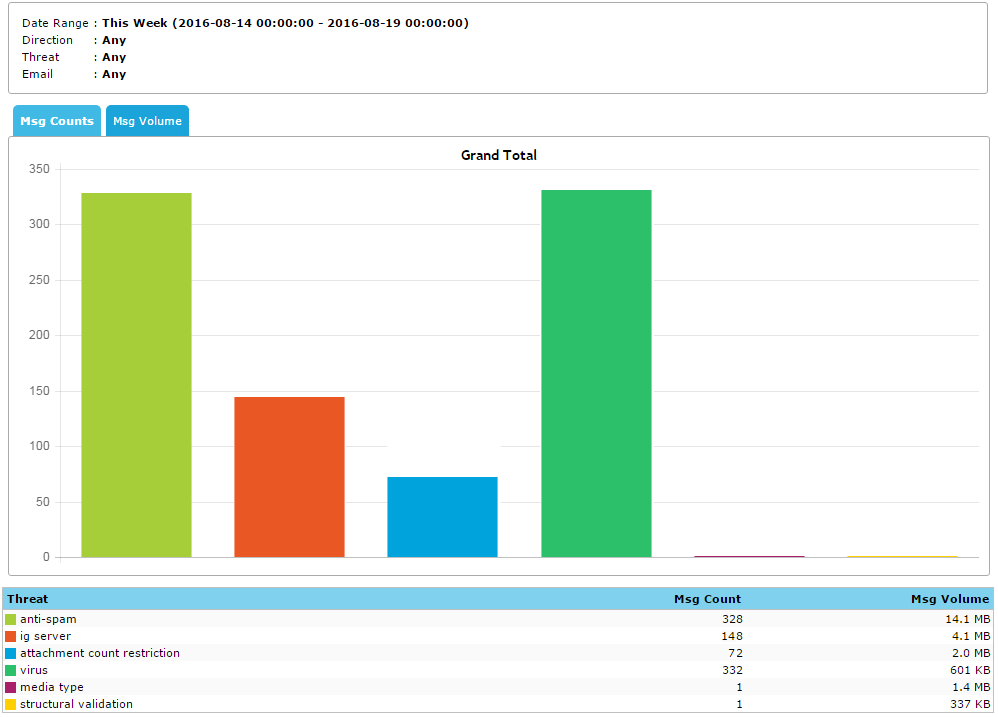Navigate to the Reports menu and select the Available Reports tab.
You can view a list of available reports on this page. You can run a report manually, at any time, to view the current results. The Reports page also provides options for configuring the reports.
Types of reports
There are two types of report:
System report
Custom report (

Custom report with a schedule)
-
System reports are the default, standard reports supplied with Secure Web Gateway.
-
You cannot edit, delete or schedule a system report.
-
If you want to create a new report, you should copy a system report and customize the copy.
-
Custom reports are both editable and deletable. You can also set a schedule.
View a report
-
Navigate to the Reports menu. The Reports page is displayed.
Select the Available Reports tab.
-
Reports are listed by category. Expand or collapse the category by clicking
 and
and  .
. -
To display custom reports only, select the Show only my reports check box.
-
-
Select a report and click
 View. Alternatively, double click the report name to run the report.
View. Alternatively, double click the report name to run the report.The report is displayed in a new browser window.
If you know the name of the report, use the Search field to narrow and match your search.
Examine report results
Report data is presented in the following format.
Summary
-
At the top of the page, summary of a report is displayed. It contains the criteria used to generate the report.
The Date Range displays the start and end dates of the selected period. For example, if you selected This Week as a date range, the explicit dates defined by the period are also displayed.
Report data
-
In the center of the page, report data is presented graphically.
Click the graphic area to cycle through the format of the report data: between bar chart, line graph and pie chart. -
Reports are often displayed by requests (numerical) or size. Select the Requests or Size tab to view the required data.
Results table
-
At the bottom of the page, a table displays results in rank or date order, depending on the report.
-
Explore the results by clicking categories or entries in the table.
Reports might be grouped by week or month as requested, If you expand the category, use the  button to switch back the view to Grand Total or Subtotal.
button to switch back the view to Grand Total or Subtotal. Why might specific information be displayed as ******?
Why might specific information be displayed as ******?
This is controlled by the Anonymize Data setting from the Users menu.
You can configure a user that is unable to view specific end-user details. For example, you create an administrator user with access to view reports but not personal information in them. This way, specific user details are hidden from the user and the data is anonymized.
When enabled, certain user details in reports will be anonymized and replaced with asterisks (******).
A user account with an Administration Role can enable or disable the Anonymize Data setting for a particular account. See Manage administrator users for more information.
Explore individual records
Certain reports, such as the ones under the Threats and Content Rules categories, enable you to explore individual records in much more detail.
-
 Example: How to view a Threats report and explore its results?
Example: How to view a Threats report and explore its results?
-
Navigate to the Reports menu. The Reports page is displayed.
Select the Available Reports tab.
-
Expand the Threats category, select a system report and click
 View. In the report, the results table displays categories and statistics about the number and size of records contained in each category.
View. In the report, the results table displays categories and statistics about the number and size of records contained in each category.  Show screenshot
Show screenshot
-
Click the threat category you want to explore. For example, select Media Type to examine the instances which were blocked because of this.
If there are sub-categories, you can continue to click each one, until individual records are displayed.
-
Export a report
You can export a report as a PDF or CSV file. You can also email a report as an attachment.
-
From the Reports > Available Reports tab, select and run a report.
-
From the Export to drop-down menu at the top right of the page, select an option:
- PDF: Reproduces the report as an open PDF file.
-
CSV: Exports the report as a comma-separated values file.
-
Email: Sends the report as a PDF attachment.
PDF files are designed to reproduce the report data concisely and efficiently. Export the report as a CSV file if you want to view the full report in detail, or you want to manipulate the data.
Summary data and detailed data
To monitor activities effectively, Secure Web Gateway manages the summary data and detailed data separately.
|
The Data Retention settings are defined on the Report Data Settings page. |
